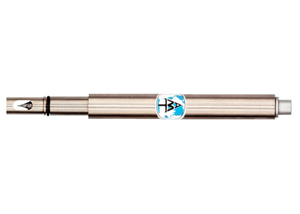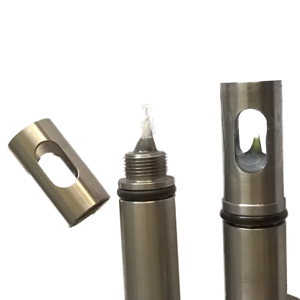laboratory hydrogen peroxide micro-sensor
amperometric hydrogen peroxide micro-sensor ES-H2O2-L
overview
- Rapid measurements of dissolved hydrogen peroxide.
- Calibrated and ready to use.
- Ideal for solutions with depths less than 1m.
- Data loggers available, if required.
The amperometric H2O2 micro-sensor has been developed for the in-situ determination of H2O2-containing aqueous solutions. Compared to all the other commercially available H2O2 measuring systems and to permanganate and iodometric methods the new micro-sensor has some advantages, such as high economy, low detection limits, low analyte consumption and fast response times. Streaming, as it is well-known from all membrane-covered sensors, is not necessary.
The laboratory sensor with integrated electronic device contains an exchange sensor tip to allow an exchange between H2O2, H2S and O2 sensor tips.
the laboratory model sensor
This sensor has been developed for the laboratory and simple field use and must be combined with one of the offered measuring instruments. The sensor consists of a titanium housing, a water-proof connection with the cable (IP 68), an exchangeable sensor head and a removable protection cage (on your own risk - no guarantee in the case of mechanical destruction).
This sensor could be equipped both with the following sensor tips: hydrogen peroxide sensor tip type I (0,02…10% H2O2). The exchange of the sensor head is very easy by pull off and push on.
determination of dissolved hydrogen peroxide in aqueous solutions
The amperometric H2O2 micro-sensor has been developed for the in-situ determination of hydrogen peroxide containing aqueous solutions. Therefore, the sensor is suitable for direct measurements in coloured and turbid solutions (wastewater), in industrial plants, but also in biological research.
Compared with all the other commercially available hydrogen peroxide sensors, this amperometric H2O2 micro-sensor works with such a low analyte consumption, that streaming of the sensor membrane or stirring of the analyte is not necessary. And, an additional stirrer is not necessary for stationary measurements.
The second advantage of the micro-sensor is the very fast response time with t90% =1-2 seconds.
The third advantage of the new micro-sensor is based on the microsensor technology itself. High signal stability, high local signal resolution allows some new applications, as for instance the profiling in μm-steps.
the general working principle of the sensor
Because of the partial pressure of the gaseous H2O2 dissolved in the sample, the analyte is separated from the inner electrolyte by means of the membrane. The membrane is only pervious to gases, so that liquids, ions and solids are not able to reach the inner electrolyte or the electrodes of the sensor.
The sensor contains inside a special electrolyte and 3 electrodes. The electrode materials have been selected and prepared very carefully to realize ideal electrochemical conditions. The time for the polarization, realized by means of the sensor’s integrated electronic device, is approximately 5…15 minutes after the first switching on or long breaks.
If the H2O2 has passed now the membrane, it reacts chemically with the redox catalyst and forms a new compound. After this, this compound is transported by diffusion to the working electrode followed by the electrochemical reaction. This causes a current depending on the hydrogen peroxide partial pressure/hydrogen peroxide concentration of the sample.
The observed current within a range of 0...400 picoamperes is converted into a voltage of 0...5 Volt inside the integrated electronic device of the sensor.
Besides, in opposite to other measuring principles, the current flow in the amperometric sensor leads to a rapid decrease of the analyte inside the sensor resulting in very fast response times even though there is a concentration jump from high to low concentrations.
All commercially available electrochemical sensors must be combined with a temperature measurement and the amperometric H2O2 sensor too. When ordering a multi-sensor measuring system for laboratory use or a complete submersible probe system, the temperature measurement and the temperature correction of the sensor signal is already included. If measurements in a flow through system are required, special temperature sensors for the integration in flow through cells are offered. When measuring in opened vessels or beakers in the laboratory, the customers must realize the temperature measurement themselves. If a calibrated sensor is ordered, the temperature correction is very easy by means of a factor or for more accurate measurements by means of a mathematical formula, delivered with the sensor.
specifications
| feature | specification |
|---|---|
| measuring priciple: | - membrane covered, amperometric sensor - 3 electrodes |
| separation: | separation of the sensor’s electrolyte from the sample by means of very thin permeation membranes which are only pervious for gases |
| polarisation voltage: | integrated electronic device for the provision of the polarisation voltage |
| sensor housing: | sensor housing made of titanium with protection cage |
| exchangeable sensor tips: | for H2O2, H2S and for O2 |
| sensor tips: | H2O2: type I: 0,02...10% H2O2 H2S: type I: 50 μg/l …10 mg/l H2S type II: 500 μg/l … 50 mg/l H2S type III: 10 μg/l … 3 mg/l H2S O2: 0...150% saturation other measuriing ranges on request |
| streaming of the membrane or stirring: | streaming of the membrane or stirring of the analyte is not necessary |
| sample contact: | he sample is in contact with the materials glass and titanium |
| accuracy: | accuracy of the sensor: 2% f.s. |
| temperature range: | for measuring and storage: 0°C ... 30°C |
| response time: | short response times |
| lifetime: | depending on H2O2 stress and on sample matrix): 5...9 months |
| signal: | not influenced by salt concentrations of up to 40 g/l |
| Regarding the electrical interfacing please check carefully the separate information sheet. *) Changes for technical improvement are reserved. |







